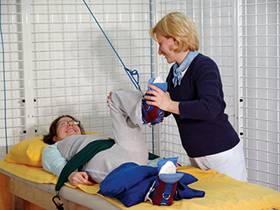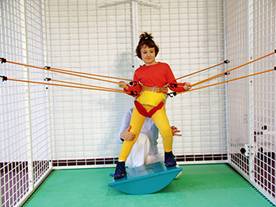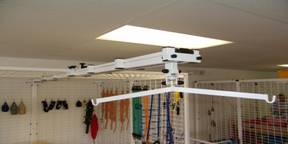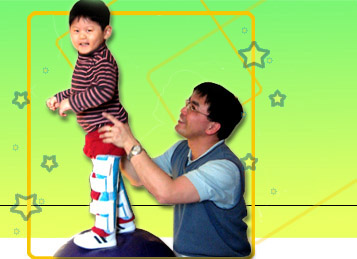|
Universal
Exercise Unit:
I.
The History of Universal Exercise Unit (UEU):
The
Universal Exercise Unit (UEU)was designed and developed in
the 1940s by a well-known orthopedic surgeon, Professor Dega,
in Poland. The concept of using Universal Exercise Unit
(UEU) was quite simple at that time: to
strengthen weak muscles. Therefore,
the main goal was to train weak single muscles or muscle groups
to improve muscle strength, tolerance, and endurance.
In Poland, Universal Exercise Unit (UEU) manipulation has
become part of the Physical Therapist curriculum in Physical
Therapy school. Nowadays, the physical therapists in
Poland generally apply this greatest invention in Orthopedic
Rehabilitation, Neurological Rehabilitation, Sports Medicine
Rehabilitation, Pediatric Rehabilitation, and other physical
therapy rehabilitation as a treatment and training equipment.
In Poland, even a small setting such as private physical therapy
clinics or well-established facilities such as physical therapy
departments in the medical centers are all equipped with UEU.
Gradually, the UEU has become the greatest invention and contribution
in the history of European Rehabilitation Medicine.
In
1999, a trained Poland physical therapist couple, Richard
and Izabela Koscienlny- parents of a disabled child, first
introduced the “Adeli Suit”, “Universal
Exercise Unit”, and the “Intensive Training Program”
in pediatric physical therapy rehabilitation into the United
States. This combination has become a new and effective
training strategy and treatment milestone in pediatric physical
therapy and exercise training in Rehabilitation Medicine.

II.
The Concepts of Universal Exercise Unit (UEU):
In
the 1940s, Professor Dega’s concept of using the Universal
Exercise Unit (UEU) was quite simple: to strengthen weak muscle.
Some patients with weaker muscles cannot effectively contract
their weak muscles, nor can they move their limbs with normal
pattern under influence of normal gravity and muscle tone.
By suspending the target limbs in the UEU to eliminate gravity
force and to reduce the weight of target limb, the target
limb begins to gradually initiate, develop, and learn the
new movement. Eliminating the gravity in the UEU makes
the strengthening exercise easier than the traditional exercises.
It also allows for isolating the desired muscle group in the
UEU. The UEU also provides the proper assistance
and resistance for weak muscles or muscle groups in the
completion of the full movement. It improves muscle
strength and muscle endurance, enhances the single movement
or the movement pattern learning, and promotes and accelerates
functional skills learning and development. As a result,
the Universal Exercise Unit has become the most effective
exercise device in muscle strengthening, and in dynamic movement
or functional skill training.
III.
The Components of the Universal Exercise Unit (UEU):
Universal
Exercise Unit (UEU) can be utilized in two different ways:
1) Pulley
System with Suspensions.
2) Suspension System (called
“Spider Cage”).
1. Pulley System: ( below
right picture 1)
It
consists of basic pulley systems, suspension cords, suspension
harness for different body parts, and sand bags with different
weights (graded every ½ Kg or 1 Kg from 0.5Kg to 3.0
Kg). The goals of this UEU pulley system are to improve
the passive/active range of joint motion, to improve the muscle
flexibility, to promote muscle strength and muscle endurance
without the influence of associated movement, and to enhance
dynamic movement or functional skill training. If a
person with neurological disorder is asked to do a certain
movement, he/she will perform the requested movement by moving
both upper and lower extremities at the same time (associated
movement) because of the influence of abnormal muscle tone,
lack of muscle strength, and insufficient graded control of
balance and coordination. By eliminating the gravity
force in the UEU along with custom-designed exercise training
programs, the trainer can isolate and train the target weak
muscle or muscle group. Patients also can perform the
movement pattern by following movement with the trainer (passive
range of motion exercise), and initiate the
movement with lateral assistance and even perform a minimum
movement with assistance (active-assistive range
of motion exercise). After that, they
can progress to participate resistive muscle strengthening
exercise training (active–resistive exercise).
On the other hand, the progress will be reflected in functional
gains, especially in graded control of active movement, quality
control of balance and coordination in postures, transitions,
locomotion and gait. This is a very crucial exercise
principle of using the UEU to train or treat patients with
neuromuscular disorders or even with orthopedic-related muscular-skeletal
dysfunction.
 
1. Pulley system using treatment
bed or chair.
2. Suspension system (called "Spider cage")
using
the belt an elastic cords
2.
Suspension System:
( above left picture 2)
The
UEU can also be combined with belt and elastic cords and can
be used in many other ways as a dynamic suspension (called
“Spider Cage”).
The patient is suspended in the middle of the UEU with unique
support received from the elastic cords acting as extra hands.
This suspension system-“Spider Cage” provides
horizontal, vertical, and even dynamic features of functional
suspension as a support, assistance, or even resistance during
training. The suspension system also provides just the
right amount of support needed for securing and balancing
patient in the UEU while practicing or performing needed movements,
transitions (side-sitting to quadruped position, side-sitting
to kneeling, kneeling to standing via a half-kneeling, sitting
to standing, and squatting to standing), or functional skill
in different developmental positions (sitting, crawling/creeping,
standing, walking, jumping, hopping, etc.) on their own, as
well as strengthening muscle, enhancing balance and coordination
training. In Spider Cage with full suspension, the patient
is able to accomplish movements or activities in an upright
position which have never been able to do or have never dreamed
to do. Depending on the progress he/she makes, the trainer
can change the location and direction of the elastic cords
attachment on the UEU, or can even change the patient’s
position (moving a little bite forward or backward, moving
a little bite to his/her right or left- even thought just
1-2 inches) in the UEU to reduce the amount of assistance
and resistance or increase the amount of bearing weight until
the patient can complete the requested tasks independently.
The other benefits of the Spider Cage are to provide body
awareness and vestibular stimulations, to promote or develop
postural reflexes (protective extension reactions, righting
or equilibrium reactions), to provide sensory-motor integration,
and to promote independence in graded control in movements
and functional skills.
IV.
The Optional Equipments for the Universal Exercise Unit (UEU):
Universal
Exercise Unit (UEU) is extremely helpful while working on
specific goals like endurance for a certain skill.
It also can be utilized in different functional training with
different optional equipments: 1) Tracking
Rail. 2)
Parallel Bars.
1.
Tracking Rail:
With
the use of the tracking rail, the patient can practice not
only ambulation but also working on 1) promoting/improving
the quality of movement and endurance in different upright
positions or transition training (creeping, kneel-walking,
kneeling to standing via a half-kneeling, sitting to standing
and walking), 2) enhancing the graded movement control in
balance and coordination (for example: promoting reciprocal
movement of upper or lower extremities). The tracking
rail is very helpful as an ambulatory training device, and
can also be used as a dynamic stander. Patients learn
the concept of weight bearing on the lower extremities in
standing and weight shifting from side to side or forward
and backward (as a pre-ambulation training) along with the
consequences in a safe way. He/ she also loves to “fly”
and “spin” as a different use with training rail.



2.
Parallel Bar:
Parallel
bars, installed inside or between the UEU, allow the trainer
to combine any of the previously mentioned concepts for gait
training, functional skill training and transfer training.
The parallel bars can also be done either independently or
with the use of the “Spider”, tracking rail.

The
Universal Exercise Unit (UEU) meets all the requirements of
FDA regulations and is FDA listed and registered. There
is no age limit to use UEU. The
weight limit is 350 pounds. Although
the clinical concept of UEU seems to be very simple,
professional certified training is required to ensure the
safety of the consumers.
Print
informaiton about
UEU
Enroll
my child
How
can I participate this program?
|



